The Friends of the Wildflower Garden, Inc.
Grasses of the Eloise Butler Wildflower Garden
The oldest public wildflower garden in the United States

Common Name
Little Bluestem (Broom Bluestem, Broom Beardgrass)
Scientific Name
Schizachyrium scoparium (Michx.) Nash var. scoparium
Plant Family
Poaceae (Grasses)
Garden Location
Upland
Prime Season
July to September flowering and seed production
Grass structure and definitions - PDF from Oregon State University
Little Bluestem is a medium height warm-season perennial grass that usually produces tufts (is said to be 'cespitose') and the tufted base may have short scaly rhizome. The flowering stem (culm) is erect, reaching 3 to 80 inches high but usually found in the range of 15 to 50 inches high.
The leaf blades are up to 3/8 inches wide (9 mm), - up to 40 inches long (100 mm), flat with a V shape center vein, and usually smooth on the surface but edges are a little rough to the touch due to a very fine serration. Blades are light blue-green, a little twisted and with a blunt tip.
The leaf sheath is split, usually keeled and often purplish at the base. Both sheaths and blades in this variety are typically without hair. The entire plant picks up a reddish cast in autumn and after a frost. The ligules are slightly fringed and short - 0.5 to 2 mm long.
Inflorescence: The flowering stem ends in what is called a 'spicate raceme', which in this species bears 3 to 12 stalked spikelet bearing branches (known as 'rames') - which is a characteristic of the genus Schizachyrium. Each branch has 6 to 13 spikelets. These rames are separated from each other on the central rachis and have hair on their internodes, sometimes for the entire rame or just the upper 1/2.
Spikelets: Spikelets are in pairs on the rame - one stalked (pedicellate) , the other sessile. Sessile spikelets are 3 to 11 mm long, have 2 florets, with glumes exceeding the florets in length, the lower glumes are flattened and keeled, lemmas delicate, divided to 1/2 their length, and with twisted awns - 2.5 to 17 mm long. The upper floret is bisexual with 3 anthers, while the lower is sterile and usually reduced to just a lemma. Pedicellate spikelets have a short stalk that is 3 to 7.5 mm long, and the spikelets - 0.7 to 10 mm long - are uusally shorter than the sessile spikelets, have only one floret that is either sterile or staminate only, and have a lemma only if they are staminate. These are either without awns or with a straight awn less than 4 mm long. When mature, the spikelets appear densely hairy with fine white hair.
Varieties and comparisons: There are three varieties of S. scoparium: Var. stoloniferum, where the plant does not form tufts and is strongly rhizomatous in the root system. The next two varieties form tufts and may or may not have some short rhizomes in the root system: Var. divergens has stalked spikelets that are always staminate, not sterile, with a lemma, and the leaf sheaths and blades have dense flattened hairs; finally there is var. scoparium where the stalked spikelets are usually sterile, and then without a lemma, and the sheaths and blades are usually smooth but may occasionally have fine hairs. A very similar plant is Andropogon virginicus (Broomsedge, also now included under the genus Schizachyrium), which has differences in the seed. Little Bluestem is a fair forage species, and a good seed provider for wildlife. See drawing below of the three varieties.
Habitat: Little Bluestem of this variety grows from a fibrous root system but may have short scaly rhizomes. It is well adapted to grow in well-drained, medium to dry soils. It has excellent drought tolerance. It also adapts to savannas, particularly open Oak woods. It was one of the dominant grasses of the Tall Grass Prairie.
Names: In Eloise Butler's time Little Bluestem was classified as Andropogon scoparius. The genus Schizachyrium, is derived from two Greek words - schizo, meaning 'to split' and achyron, meaning 'chaff', together referring the the divided chaff (the lemma) of the spikelet. The species name, scoparium, is from the Greek scopa, meaning 'broom' and refers to the shape of the tuft of the plant resembling an old-time broom. The authorship of the plant classification: The first to publish was ‘Michx.’ which refers to Andre Michaux (1746-1802), French botanist who made many exploring expeditions in the U.S. collecting and cataloging many species. Two important works of his are the Histoire des chênes de l'Amérique septentrionale (1801 - Oaks of North America), and the Flora Boreali-Americana (2 vols., 1803). His son Francois, traveled with him and the father’s notes were later used for the 3-volume North American Sylva, for which Thomas Nuttall provided some supplements. Michaux's work was updated by ‘Nash’ which refers to George Valentine Nash (1864-1921) American botanist who worked at the New York Botanical Garden.
Landscape: There are three native varieties of Little Bluestem but in Minnesota the only variety commonly found is var. scoparium. For the home garden the nursery trade offers several cultivars. You can view a number of them in the ornamental grass collection at the Minnesota Landscape Arboretum. A particularly good cultivar is one of the "MiniBlueA" selections called "BlueHeaven™". It has little tendency to lodge during late summer as some cultivars do, and has great fall color and forms a cascading clump of leaves (photo below). See also our article an Ornamental Landscape Grasses.
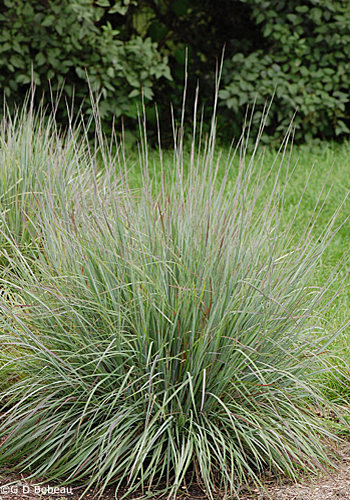
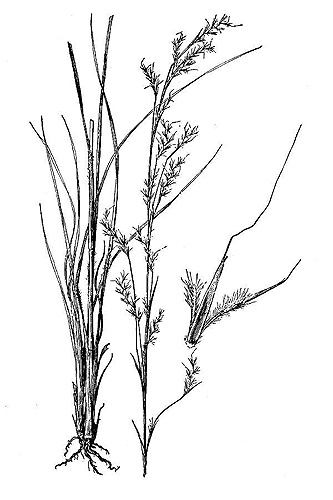
Above: A clump of Little Bluestem approaching seed maturity. Drawing courtesy USDA-NRCS PLANTS Database / Hitchcock, A.S. (rev. A. Chase). 1950. Manual of the grasses of the United States. USDA Miscellaneous Publication No. 200. Washington, DC.
Below: 1st and 2nd photos - The split leaf sheath and ligule. 3rd photo - The dense hair of the mature spikelets.
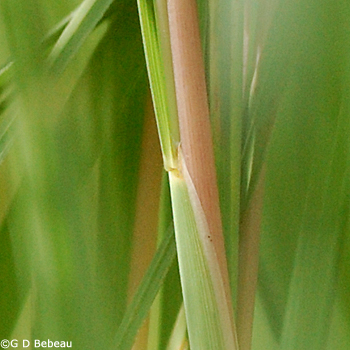

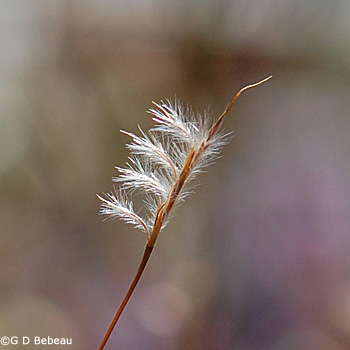
Below: 1st photo - anthers and the fuzzy stigma of a sessile fertile spikelet. 2nd photo - Little Bluestem in late September with seed heads appearing white due to the white hair on the seeds and the reddish cast to the stems. Cultivar 'BlueHeaven™' shown.
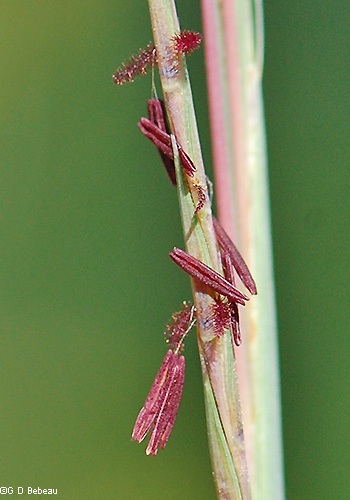
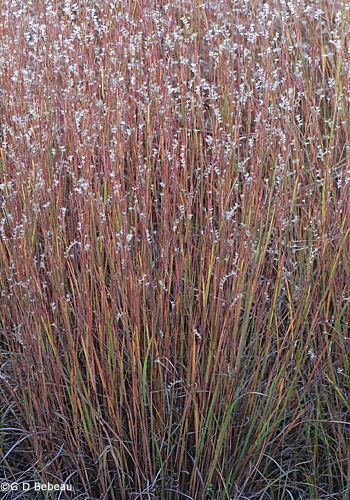
Below: A clump of BlueHeaven™ with purplish fall color beginning to show. Note the nice clump form this cultivar has and the upright stems still sturdy at the end of the season.
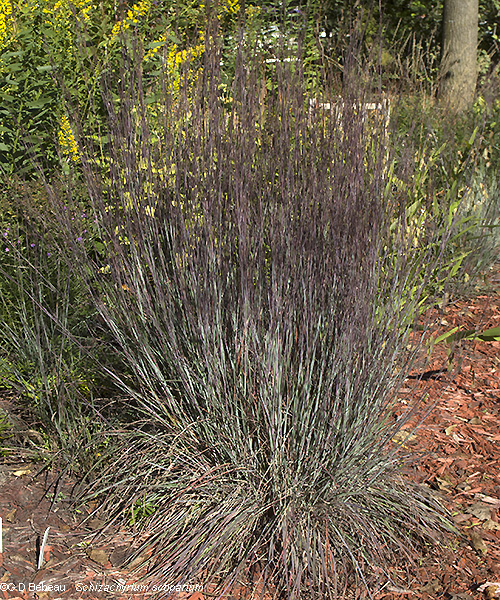
Below: The leaf blade is flat with a V-shaped main vein. Edges are slightly rough due to a very fine serration. 2nd photo - the underside shows the definite keel of the mid-vein.

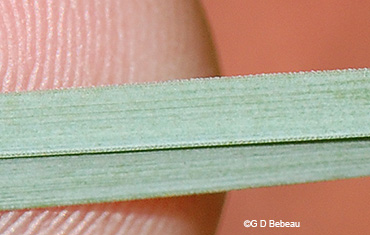
Below: Drawing of the three varieties of Schizachyrium scoparium. Drawing by Linda A. Vorobik. ©Utah State University.

Notes: Little Bluestem is not indigenous to the immediate Garden space but is indigenous to the local area. It was introduced to the Garden by Eloise Butler on Sept. 20, 1915 when she transplanted a large clump from Glenwood Park (now called Theodore Wirth Park), which partially surrounds the Garden. She planted more in 1916. Little Bluestem has been noted on both the 1986 and 2009 Garden census.
Little Bluestem is one of the most widely distributed native grasses in North America, found in all the states but Oregon and Nevada, and in all the lower Canadian Provinces. In Minnesota only one variety is found - var. scoparium and it is widespread, absent mostly in the counties of the NE quadrant. There are about 60 species of the genus in the world with nine in North America, of which S. scoparium is the best known.
Return to -- Site Plan/Archive Index --or-- List of Common Plant Names -- or -- List of Scientific Names -- or --Home Page - - - Back to top.
References: Plant characteristics are generally from sources 1A, 32, W2, W3, W7 & W8 plus others as specifically applied. Distribution principally from W1, W2 and 28C. Planting history generally from 1, 4 & 4a. Other sources by specific reference. See Reference List for details.
 Identification booklet for most of the flowering forbs and small flowering shrubs of the Eloise Butler Wildflower Garden. Details Here.
Identification booklet for most of the flowering forbs and small flowering shrubs of the Eloise Butler Wildflower Garden. Details Here.
©2014
Friends of the Wildflower Garden, Inc. Text and photos are by G. D. Bebeau unless otherwise credited. "www.friendsofeloisebutler.org"
040620